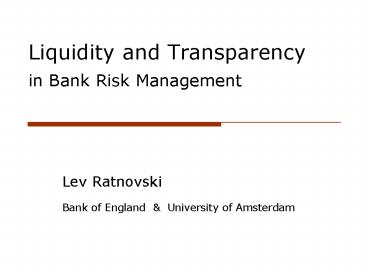Liquidity and Transparency in Bank Risk Management - PowerPoint PPT Presentation
1 / 16
Title:
Liquidity and Transparency in Bank Risk Management
Description:
of solvency info enable refinancing. Both - strategic ex-ante decisions ... at 1 risk-free interest. A bank with an ... When costs are sufficiently low... – PowerPoint PPT presentation
Number of Views:167
Avg rating:3.0/5.0
Title: Liquidity and Transparency in Bank Risk Management
1
Liquidity and Transparencyin Bank Risk Management
- Lev Ratnovski
- Bank of England University of Amsterdam
2
Liquidity Risk
- A solvent bank cannot refinance
- Stylized facts (recent events)
- Solvency concerns
- 1991, Citibank and Standard Chartered (HK)
- 1998, Lehman Brothers
- 2002, Commerzbank
- Strain in wholesale finance
- 2006, BAWAG, 5 retail withdrawals
3
Liquidity and Transparency
- Two ways to manage liquidity risk
- Liquidity
- buffer of short-term assets
- Transparency
- mechanisms that facilitates communicationof
solvency info ? enable refinancing - Both - strategic ex-ante decisions
- Optimal choices, interaction, policy implications
4
Strategic Transparency
- Invest today into ability to borrow tomorrow
- Transparency ex-ante
- Disclosure ex-post info release
- Uncertain credibility / effectiveness
- Examples
- Subordinated debt
- Risk management / external oversight
- Streamlining LCFIs
- Commitment to credible disclosure
- Citicorp 1987 provisions 3bn, positive reaction
5
Strategic Transparency
- Imperfect
- Country determinants
- Industry effects externalities / coordination
- Many everyday beneficial effects
- Better screening / monitoring
- Lower funding costs
- Most pronounced in unforeseen shocks
- Highest asymmetric information
6
Main results
- Banks can combine liquidity and transparency in
risk management - Liquidity small shocks, complete
- Transparency all shocks, partial
- Banks may under-invest in both
- Leverage (or LOLR or externalities)
- Regulation complicated by multitasking
- Liquidity requirements can compromise
transparency choices
7
Policy
- Solvency is not enough
- Asymmetric info ? Liquidity risk
- Liquidity regulation
- If incorrect, can compromise transparency
- Extra emphasis on transparency beneficial
8
Set-up
- Liquidity risk driven by asymmetric information
- Wholesale refinancing for known solvent banks
- Bank has a valuable long-term project
- Small probability of 0 return
- Does not prevent initial funding
- Intermediate refinancing
- Exogenous random withdrawal
- Most states bank confirmed solvent,investors
willing to refinance - Risk negative signal (possible for a solvent
bank), no refinancing
9
Economy
- Multiple competitive investors
- Endowed with money
- Lend at 1 risk-free interest
- A bank with an investment project
- Date 0 Investment
- Date 1 Refinancing
- Date 2 Returns,
- per unit invested X w.p. 1s
- 0 w.p. s (s small)
- A bank does not borrow more than 1 at date 0
10
Intermediate Refinancing date 1
- Random withdrawal, Llt1 or 1 w.p. ½
- Uninformed depositors
- Maturing term liabilities
- Noisy solvency signal
- Fundamentals solvent 1s, insolvent s
- Probability 1sq correct signal solvent
- Outsiders willing to refinance
- Probability sq possibly insolvent
- High posterior insolvency s /(sq) gt s
- Outsiders unwilling to refinance, incl q solvent
banks
11
Insolvent
Solvent 1s
s
Negative signal,pooled together
Positive signal, known solvent
1sq
s
q
Solvent,but unableto refinance
12
Hedging
- Liquidity buffer
- Invest L into short-term assets
- Covers small outflows internally
- Not suitable for large outflows
- Complete insurance against small shocks
- Transparency
- Invest T to establish communication mech-ms
- Helps resolve uncertainty, refinance any shocks
- Effective only with probability tlt1
- Partial insurance against any shocks
13
Transparency
- Effectiveness t
- Probability of successful communication
- Exogenous to banks decision
- Determinants
- Financial development
- Market size / liquidity
- Other banks externalities (Admati and
Pfheiderer, 2000) or coordination
14
Optimal choices
- Liquidity and transparency are costly hedges
- When costs are sufficiently low
- Banks can optimally combine liquidity and
transparency in risk management - Liquidity small shocks, complete
- Transparency large shocks, partial
15
Distortion
- Banks are leveraged ?
- Can under-invest in bothliquidity and
transparency - Alternative set-ups possible(LOLR rents or
systemic externalities)
16
Regulation
- Liquidity is verifiable ? impose ratios
- Transparency ? ?
- Multi-tasking
- Liquidity requirements can compromisetransparency
choices - Impose too much liquidity on transparent
banks,get liquidity only exposure to larger
shocks
17
Contribution
- Novel model of liquidity risk
- Closest Chari and Jagannathan, 1988
- Consumer runs under asymmetric information
- Uninformed observe a withdrawalMay be not
information-basedAmplification of liquidity
withdrawals - No refinancing
- Our approach
- Wholesale funding under asymmetric information
- Downplay withdrawalsKnown solvent can
refinance, Goodfriend and King, 1988 - Refinancing problem Imprecise info of informed
investors - How to prove solvency?
- Liability-side liquidity risk, but no bank runs
- Reflects flight to quality
18
- Is cash negative debt?
- Acharya at al., 2006 future access to finance is
uncertain - Financial constraints
- Kashyap and Stein, 2000 Paravisini, 2006
- Jointly determined by liquidity and transparency
- Empirical implications
19
Main results
- Banks may combine liquidity buffers and
transparency investments in risk mgmt - Liquidity fully insures small shocksTransparency
partially all shocks - Both may be compromised by leverageRegulation
complicated by multitasking - Lessons for liquidity regulation
- If incorrect, can compromise transparency
- Important that thoroughly designed
- May require extra emphasis on transparency
20
Main results
- Banks can combine liquidity and transparency in
risk management - Banks may under-invest in both
- Regulation is complicated by multitasking
- Lessons for liquidity regulation
- Solvency regulation not enough
- Incorrect liquidity requirements can compromise
transparency choices - Additional emphasis on transparency beneficial































